engine OPEL COMBO 2010 Workshop Manual
[x] Cancel search | Manufacturer: OPEL, Model Year: 2010, Model line: COMBO, Model: OPEL COMBO 2010Pages: 212, PDF Size: 2.49 MB
Page 157 of 212
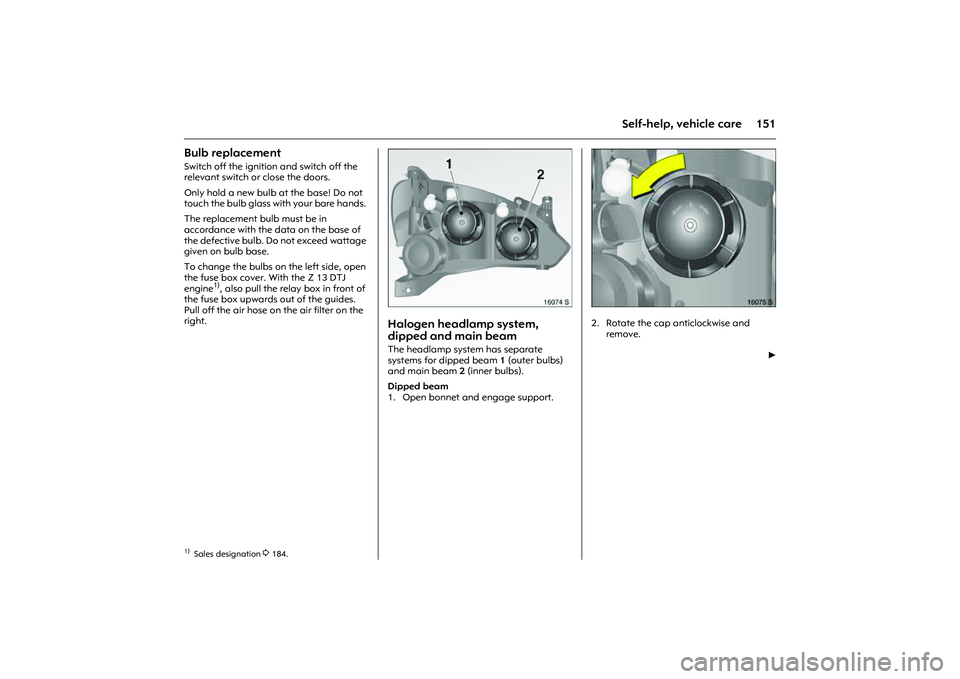
151
Self-help, vehicle care
Bulb replacement Switch off the ignition and switch off the
relevant switch or close the doors.
Only hold a new bulb at the base! Do not
touch the bulb glass with your bare hands.
The replacement bulb must be in
accordance with the data on the base of
the defective bulb. Do not exceed wattage
given on bulb base.
To change the bulbs on the left side, open
the fuse box cover. With the Z 13 DTJ
engine
1), also pull the relay box in front of
the fuse box upwards out of the guides.
Pull off the air hose on the air filter on the
right.
Picture no: 16074s.tif
Halogen headlamp system,
dipped and main beam The headlamp system has separate
systems for dipped beam 1 (outer bulbs)
and main beam 2 (inner bulbs).
Dipped beam
1. Open bonnet and engage support.
Picture no: 16075s.tif
2. Rotate the cap anticlockwise and
remove.
6
1)Sales designation
3184.
Page 168 of 212
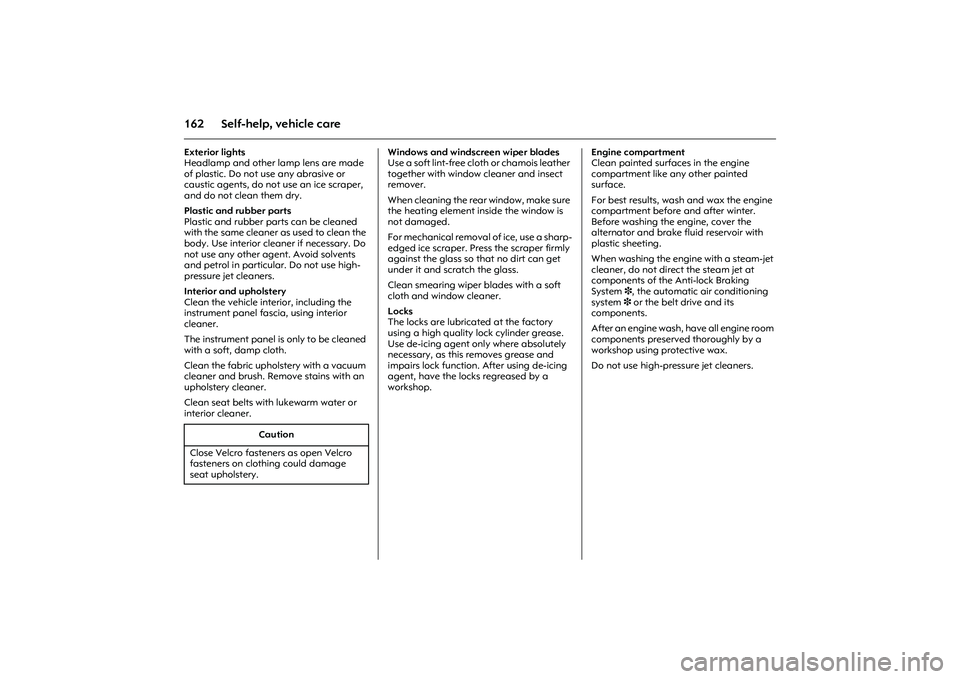
162 Self-help, vehicle careExterior lights
Headlamp and other lamp lens are made
of plastic. Do not use any abrasive or
caustic agents, do not use an ice scraper,
and do not clean them dry.
Plastic and rubber parts
Plastic and rubber parts can be cleaned
with the same cleaner as used to clean the
body. Use interior cleaner if necessary. Do
not use any other agent. Avoid solvents
and petrol in particular. Do not use high-
pressure jet cleaners.
Interior and upholstery
Clean the vehicle interior, including the
instrument panel fascia, using interior
cleaner.
The instrument panel is only to be cleaned
with a soft, damp cloth.
Clean the fabric upholstery with a vacuum
cleaner and brush. Remove stains with an
upholstery cleaner.
Clean seat belts with lukewarm water or
interior cleaner. Windows and windscreen wiper blades
Use a soft lint-free cloth or chamois leather
together with window cleaner and insect
remover.
When cleaning the rear window, make sure
the heating element inside the window is
not damaged.
For mechanical removal of ice, use a sharp-
edged ice scraper. Press the scraper firmly
against the glass so that no dirt can get
under it and scratch the glass.
Clean smearing wiper blades with a soft
cloth and window cleaner.
Locks
The locks are lubricated at the factory
using a high quality lock cylinder grease.
Use de-icing agent only where absolutely
necessary, as this removes grease and
impairs lock function. After using de-icing
agent, have the locks regreased by a
workshop. Engine compartment
Clean painted surfaces in the engine
compartment like any other painted
surface.
For best results, wash and wax the engine
compartment before and after winter.
Before washing the engine, cover the
alternator and brake fluid reservoir with
plastic sheeting.
When washing the engine with a steam-jet
cleaner, do not direct the steam jet at
components of the Anti-lock Braking
System 3, the automatic air conditioning
system 3 or the belt drive and its
components.
After an engine wash, have all engine room
components preserved thoroughly by a
workshop using protective wax.
Do not use high-pressure jet cleaners.
Caution
Close Velcro fasteners as open Velcro
fasteners on clothing could damage
seat upholstery.
Page 169 of 212
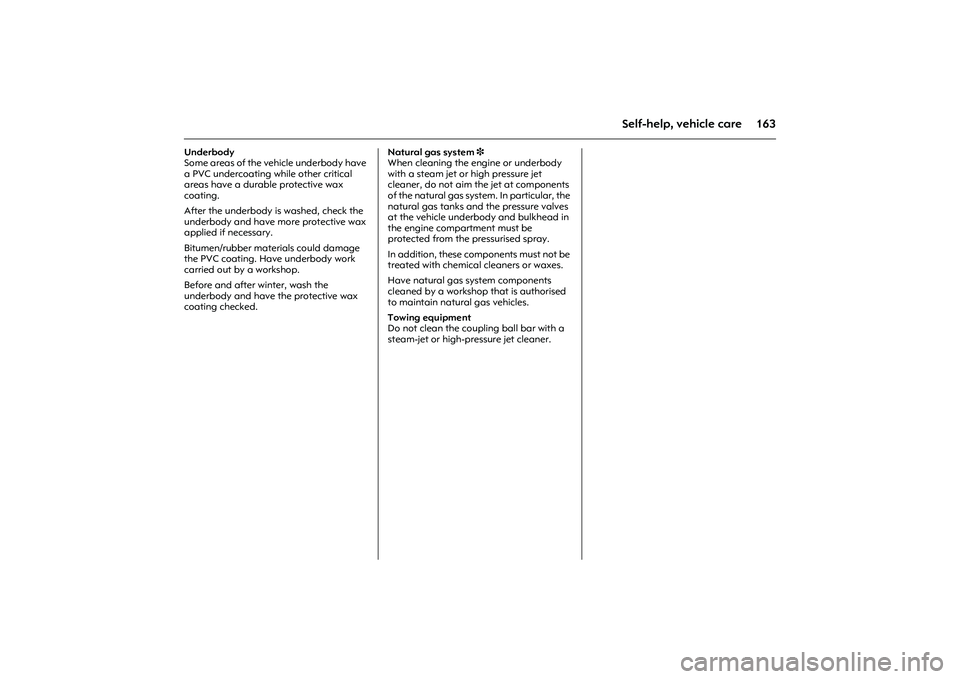
163
Self-help, vehicle care
Underbody
Some areas of the vehicle underbody have
a PVC undercoating while other critical
areas have a durable protective wax
coating.
After the underbody is washed, check the
underbody and have more protective wax
applied if necessary.
Bitumen/rubber materials could damage
the PVC coating. Have underbody work
carried out by a workshop.
Before and after winter, wash the
underbody and have the protective wax
coating checked. Natural gas system3
When cleaning the engine or underbody
with a steam jet or high pressure jet
cleaner, do not aim the jet at components
of the natural gas system. In particular, the
natural gas tanks and the pressure valves
at the vehicle underbody and bulkhead in
the engine compartment must be
protected from the pressurised spray.
In addition, these components must not be
treated with chemical cleaners or waxes.
Have natural gas system components
cleaned by a workshop that is authorised
to maintain natural gas vehicles.
Towing equipment
Do not clean the coupling ball bar with a
steam-jet or high-pressure jet cleaner.
Page 170 of 212
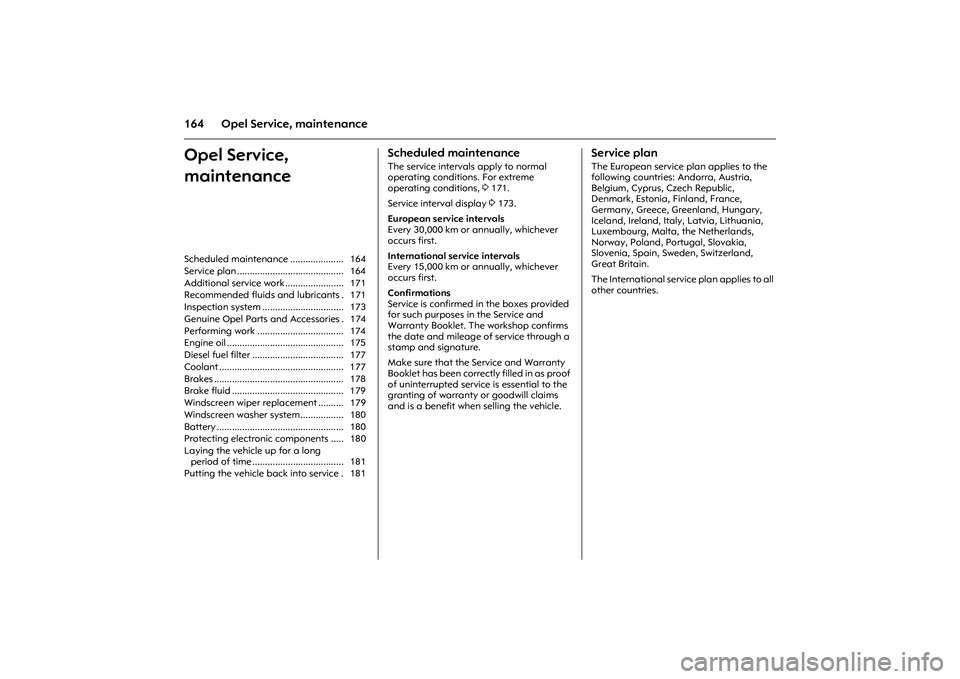
164 Opel Service, maintenanceOpel Service,
maintenance
Scheduled maintenanceThe service intervals apply to normal
operating conditions. For extreme
operating conditions, 3171.
Service interval display 3173.
European service intervals
Every 30,000 km or annually, whichever
occurs first.
International service intervals
Every 15,000 km or annually, whichever
occurs first.
Confirmations
Service is confirmed in the boxes provided
for such purposes in the Service and
Warranty Booklet. The workshop confirms
the date and mileage of service through a
stamp and signature.
Make sure that the Service and Warranty
Booklet has been correctly filled in as proof
of uninterrupted service is essential to the
granting of warranty or goodwill claims
and is a benefit when selling the vehicle.
Service planThe European service plan applies to the
following countries: Andorra, Austria,
Belgium, Cyprus, Czech Republic,
Denmark, Estonia, Finland, France,
Germany, Greece, Greenland, Hungary,
Iceland, Ireland, Italy, Latvia, Lithuania,
Luxembourg, Malta, the Netherlands,
Norway, Poland, Portugal, Slovakia,
Slovenia, Spain, Sweden, Switzerland,
Great Britain.
The International service plan applies to all
other countries. Scheduled maintenance ..................... 164
Service plan .......................................... 164
Additional service work ....................... 171
Recommended fluids and lubricants . 171
Inspection system ................................ 173
Genuine Opel Parts and Accessories . 174
Performing work .................................. 174
Engine oil .............................................. 175
Diesel fuel filter .................................... 177
Coolant ................................................. 177
Brakes ................................................... 178
Brake fluid ............................................ 179
Windscreen wiper replacement .......... 179
Windscreen washer system ................. 180
Battery .................................................. 180
Protecting electronic components ..... 180
Laying the vehicle up for a long
period of time .................................... 181
Putting the vehicle back into service . 181
Page 172 of 212
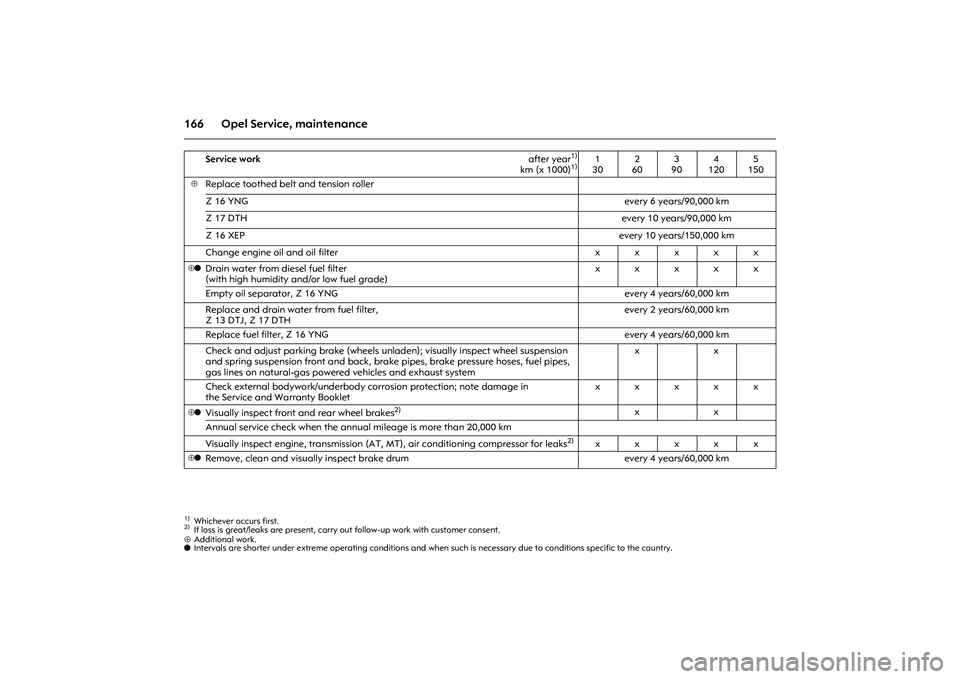
166 Opel Service, maintenance⊕Additional work.
o Intervals are shorter under extreme operating conditions and when such is necessary due to conditions specific to the country.
Service work after year
1)
km (x 1000)
1)
1)Whichever occurs first.
1
302
603
904
1205
150
⊕
Replace toothed belt and tension roller
Z 16 YNGevery 6 years/90,000 km
Z 17 DTHevery 10 years/90,000 km
Z 16 XEPevery 10 years/150,000 km
Change engine oil and oil filter x x x x x
⊕o
Drain water from diesel fuel filter
(with high humidity and/or low fuel grade)xxxxx
Empty oil separator, Z 16 YNG every 4 years/60,000 km
Replace and drain water from fuel filter,
Z 13 DTJ, Z 17 DTHevery 2 years/60,000 km
Replace fuel filter, Z 16 YNG every 4 years/60,000 km
Check and adjust parking brake (wheels unladen); visually inspect wheel suspension
and spring suspension front and back, brake pipes, brake pressure hoses, fuel pipes,
gas lines on natural-gas powered vehicles and exhaust systemxx
Check external bodywork/underbody corrosion protection; note damage in
the Service and Warranty Bookletxxxxx
⊕o
Visually inspect front and rear wheel brakes
2)
2)If loss is great/leaks are present, carry out follow-up work with customer consent.
xx
Annual service check when the annual mileage is more than 20,000 km
Visually inspect engine, transmission (AT, MT), air conditioning compressor for leaks
2)
xxxxx
⊕o
Remove, clean and visually inspect brake drum every 4 years/60,000 km
Page 173 of 212
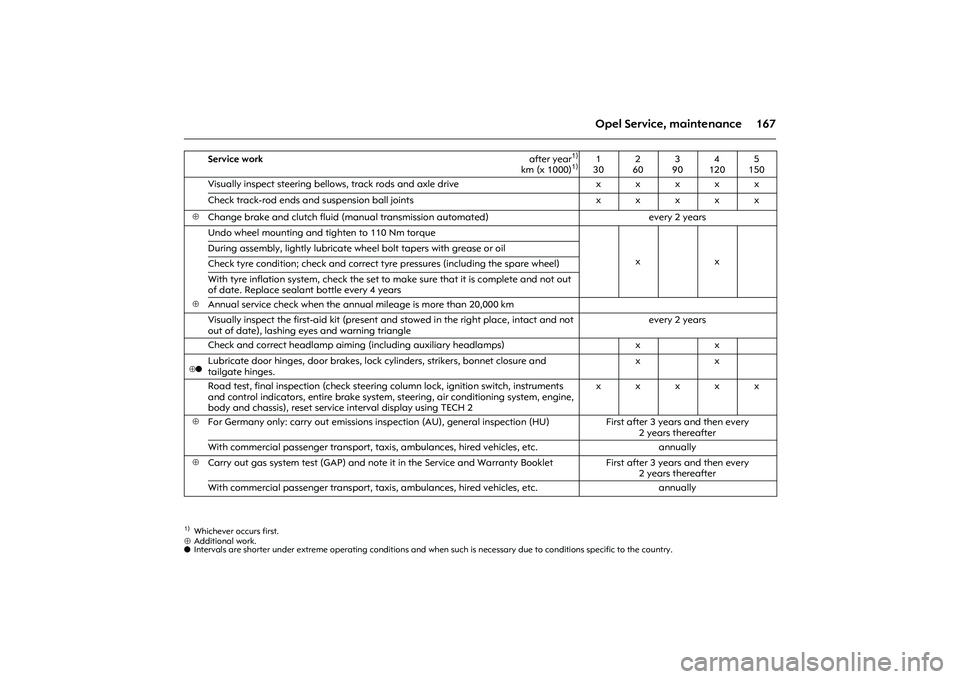
167 Opel Service, maintenance
⊕Additional work.
o Intervals are shorter under extreme operating conditions and when such is necessary due to conditions specific to the country.
Service work after year
1)
km (x 1000)
1)
1)Whichever occurs first.
1
302
603
904
1205
150
Visually inspect steering bellows, track rods and axle drive xxxxx
Check track-rod ends and suspension ball joints xxxxx
⊕
Change brake and clutch fluid (manual transmission automated) every 2 years
Undo wheel mounting and tighten to 110 Nm torque
xx During assembly, lightly lubricate wheel bolt tapers with grease or oil
Check tyre condition; check and correct tyre pressures (including the spare wheel)
With tyre inflation system, check the set to make sure that it is complete and not out
of date. Replace sealant bottle every 4 years
⊕
Annual service check when the annual mileage is more than 20,000 km
Visually inspect the first-aid kit (present and stowed in the right place, intact and not
out of date), lashing eyes and warning triangleevery 2 years
Check and correct headlamp aiming (including auxiliary headlamps) x x
⊕o
Lubricate door hinges, door brakes, lock cylinders, strikers, bonnet closure and
tailgate hinges.xx
Road test, final inspection (check steering column lock, ignition switch, instruments
and control indicators, entire brake system, steering, air conditioning system, engine,
body and chassis), reset service interval display using TECH 2xxxxx
⊕
For Germany only: carry out emissions inspection (AU), general inspection (HU) First after 3 years and then every
2 years thereafter
With commercial passenger transport, taxis, ambulances, hired vehicles, etc. annually
⊕
Carry out gas system test (GAP) and note it in the Service and Warranty Booklet First after 3 years and then every
2 years thereafter
With commercial passenger transport, taxis, ambulances, hired vehicles, etc. annually
Page 175 of 212
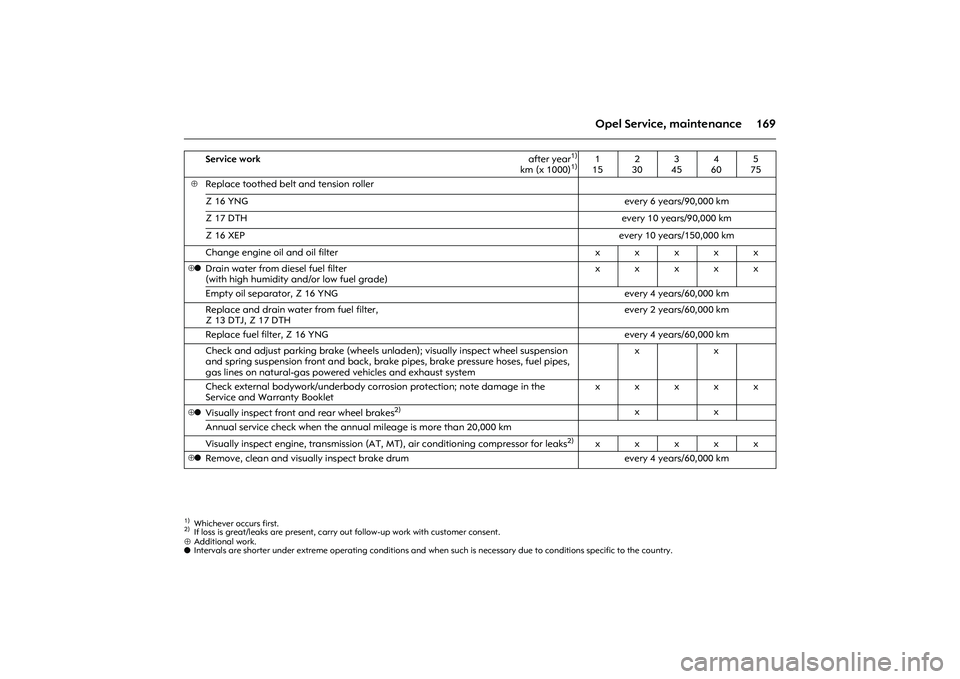
169 Opel Service, maintenance
⊕Additional work.
o Intervals are shorter under extreme operating conditions and when such is necessary due to conditions specific to the country.
Service work after year
1)
km (x 1000)
1)
1)Whichever occurs first.
1
152
303
454
605
75
⊕
Replace toothed belt and tension roller
Z 16 YNGevery 6 years/90,000 km
Z 17 DTHevery 10 years/90,000 km
Z 16 XEPevery 10 years/150,000 km
Change engine oil and oil filter x x x x x
⊕o
Drain water from diesel fuel filter
(with high humidity and/or low fuel grade)xxxxx
Empty oil separator, Z 16 YNG every 4 years/60,000 km
Replace and drain water from fuel filter,
Z 13 DTJ, Z 17 DTHevery 2 years/60,000 km
Replace fuel filter, Z 16 YNG every 4 years/60,000 km
Check and adjust parking brake (wheels unladen); visually inspect wheel suspension
and spring suspension front and back, brake pipes, brake pressure hoses, fuel pipes,
gas lines on natural-gas powered vehicles and exhaust systemxx
Check external bodywork/underbody corrosion protection; note damage in the
Service and Warranty Bookletxxxxx
⊕o
Visually inspect front and rear wheel brakes
2)
2)If loss is great/leaks are present, carry out follow-up work with customer consent.
xx
Annual service check when the annual mileage is more than 20,000 km
Visually inspect engine, transmission (AT, MT), air conditioning compressor for leaks
2)
xxxxx
⊕o
Remove, clean and visually inspect brake drum every 4 years/60,000 km
Page 176 of 212
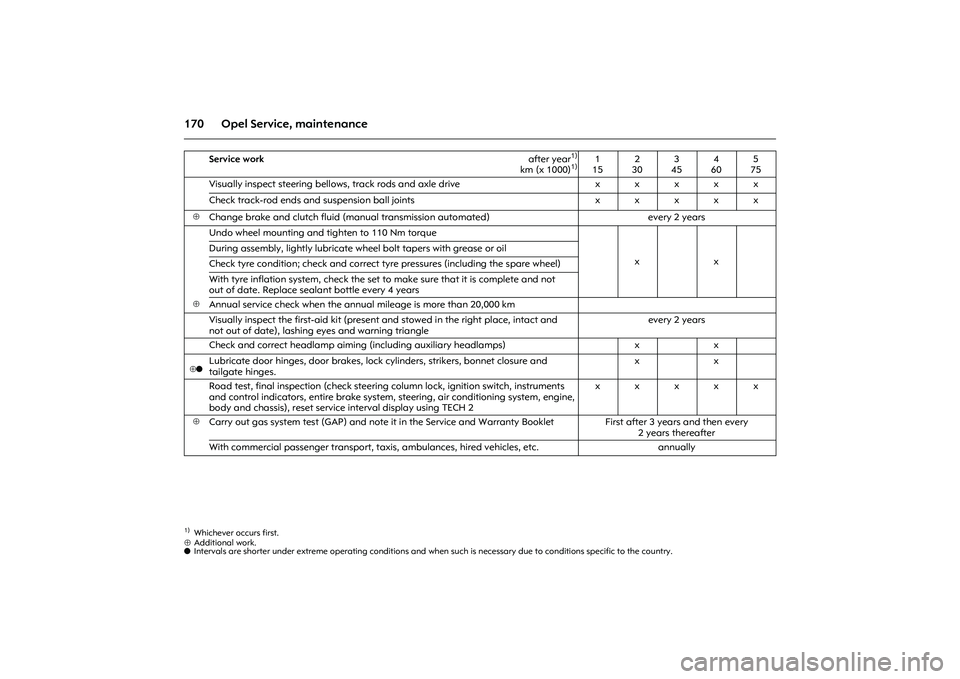
170 Opel Service, maintenance⊕Additional work.
o Intervals are shorter under extreme operating conditions and when such is necessary due to conditions specific to the country.
Service work after year
1)
km (x 1000)
1)
1)Whichever occurs first.
1
152
303
454
605
75
Visually inspect steering bellows, track rods and axle drive x x x x x
Check track-rod ends and suspension ball joints x x x x x
⊕
Change brake and clutch fluid (manual transmission automated) every 2 years
Undo wheel mounting and tighten to 110 Nm torque
xx During assembly, lightly lubricate wheel bolt tapers with grease or oil
Check tyre condition; check and correct tyre pressures (including the spare wheel)
With tyre inflation system, check the set to make sure that it is complete and not
out of date. Replace sealant bottle every 4 years
⊕
Annual service check when the annual mileage is more than 20,000 km
Visually inspect the first-aid kit (present and stowed in the right place, intact and
not out of date), lashing eyes and warning triangleevery 2 years
Check and correct headlamp aiming (including auxiliary headlamps) x x
⊕o
Lubricate door hinges, door brakes, lock cylinders, strikers, bonnet closure and
tailgate hinges.xx
Road test, final inspection (check steering column lock, ignition switch, instruments
and control indicators, entire brake system, steering, air conditioning system, engine,
body and chassis), reset service interval display using TECH 2xxxxx
⊕
Carry out gas system test (GAP) and note it in the Service and Warranty Booklet First after 3 years and then every
2 years thereafter
With commercial passenger transport, taxis, ambulances, hired vehicles, etc. annually
Page 178 of 212
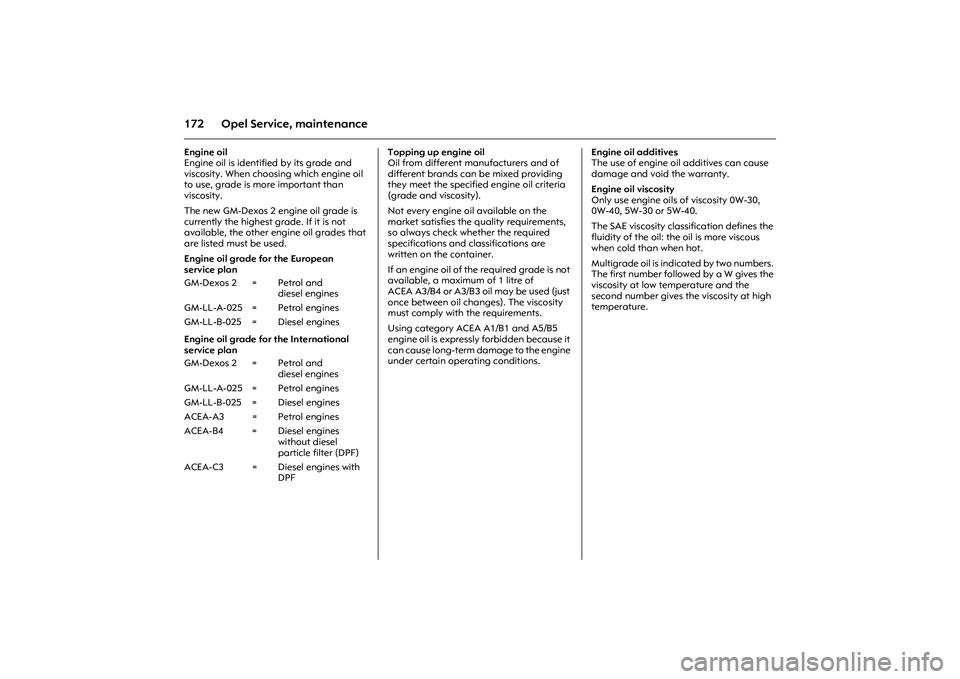
172 Opel Service, maintenanceEngine oil
Engine oil is identified by its grade and
viscosity. When choosing which engine oil
to use, grade is more important than
viscosity.
The new GM-Dexos 2 engine oil grade is
currently the highest grade. If it is not
available, the other engine oil grades that
are listed must be used.
Engine oil grade for the European
service plan
Engine oil grade for the International
service planTopping up engine oil
Oil from different manufacturers and of
different brands can be mixed providing
they meet the specified engine oil criteria
(grade and viscosity).
Not every engine oil available on the
market satisfies the quality requirements,
so always check whether the required
specifications and classifications are
written on the container.
If an engine oil of the required grade is not
available, a maximum of 1 litre of
ACEA A3/B4 or A3/B3 oil may be used (just
once between oil changes). The viscosity
must comply with the requirements.
Using category ACEA A1/B1 and A5/B5
engine oil is expressly forbidden because it
can cause long-term damage to the engine
under certain operating conditions.Engine oil additives
The use of engine oil additives can cause
damage and void the warranty.
Engine oil viscosity
Only use engine oils of viscosity 0W-30,
0W-40, 5W-30 or 5W-40.
The SAE viscosity classification defines the
fluidity of the oil: the oil is more viscous
when cold than when hot.
Multigrade oil is indicated by two numbers.
The first number followed by a W gives the
viscosity at low temperature and the
second number gives the viscosity at high
temperature. GM-Dexos 2 = Petrol and
diesel engines
GM-LL-A-025 = Petrol engines
GM-LL-B-025 = Diesel engines
GM-Dexos 2 = Petrol and
diesel engines
GM-LL-A-025 = Petrol engines
GM-LL-B-025 = Diesel engines
ACEA-A3 = Petrol engines
ACEA-B4 = Diesel engines
without diesel
particle filter (DPF)
ACEA-C3 = Diesel engines with
DPF
Page 179 of 212
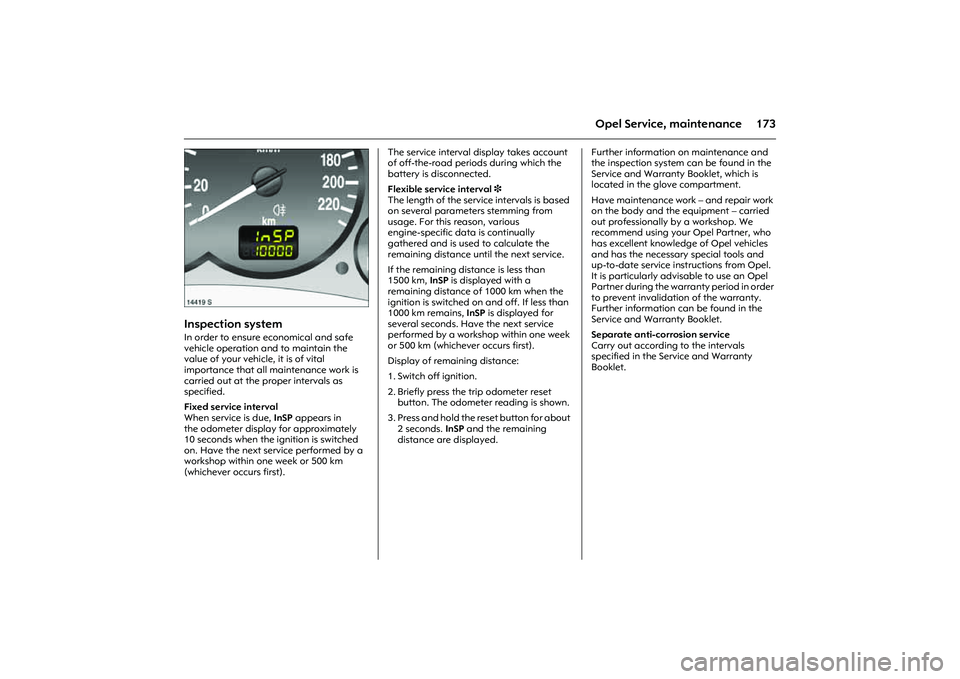
173
Opel Service, maintenance
Picture no: 14419s.tif
Inspection systemIn order to ensure economical and safe
vehicle operation and to maintain the
value of your vehicle, it is of vital
importance that all maintenance work is
carried out at the proper intervals as
specified.
Fixed service interval
When service is due, InSP appears in
the odometer display for approximately
10 seconds when the ignition is switched
on. Have the next service performed by a
workshop within one week or 500 km
(whichever occurs first). The service interval display takes account
of off-the-road periods during which the
battery is disconnected.
Flexible service interval 3
The length of the service intervals is based
on several parameters stemming from
usage. For this reason, various
engine-specific data is continually
gathered and is used to calculate the
remaining distance until the next service.
If the remaining distance is less than
1500 km, InSP is displayed with a
remaining distance of 1000 km when the
ignition is switched on and off. If less than
1000 km remains, InSP is displayed for
several seconds. Have the next service
performed by a workshop within one week
or 500 km (whichever occurs first).
Display of remaining distance:
1. Switch off ignition.
2. Briefly press the trip odometer reset
button. The odometer reading is shown.
3. Press and hold the reset button for about
2 seconds. InSP and the remaining
distance are displayed. Further information on maintenance and
the inspection system can be found in the
Service and Warranty Booklet, which is
located in the glove compartment.
Have maintenance work – and repair work
on the body and the equipment – carried
out professionally by a workshop. We
recommend using your Opel Partner, who
has excellent knowledge of Opel vehicles
and has the necessary special tools and
up-to-date service instructions from Opel.
It is particularly advisable to use an Opel
Partner during the warranty period in order
to prevent invalidation of the warranty.
Further information can be found in the
Service and Warranty Booklet.
Separate anti-corrosion service
Carry out according to the intervals
specified in the Service and Warranty
Booklet.